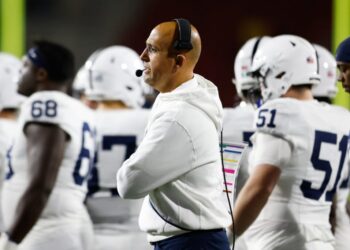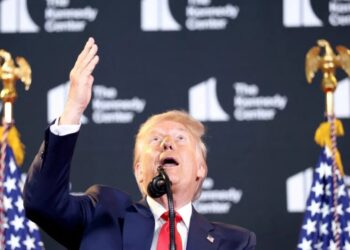Top officials at the Federal Reserve’s Washington headquarters and 12 reserve banks received a short memo on Oct. 29 with an unmistakable message. The way the central bank had long monitored and addressed risks across the financial system was in for a drastic overhaul.
The memo, which was reviewed by The New York Times, contained a list of directives for Fed examiners and supervisory staff across the country that significantly curtailed how closely they scrutinized lenders. It followed a host of changes made by Michelle W. Bowman, a Fed governor, who since becoming vice chair for supervision at the start of the summer had been providing regulatory relief to banks. One day after the memo was sent, Ms. Bowman announced a 30 percent cut in staff across her division in Washington.
Current and former policymakers and legal experts were already worried that those changes would encourage exactly the kind of risk-taking that could sow the seeds for the next crisis. But the sweeping nature of the plans outlined in the memo is likely to further fan fears that supervisors will be less equipped to spot such a crisis in advance, risking deeper damage to the economy.
“As a guiding principle, staff should not assume that our current or past operating practices should continue going forward,” the memo said. Staff “should take note of the significant shift in direction and implement the changes necessary to align our supervisory work and messaging with this new approach.”
The memo was sent by Mary Aiken, acting director of the Fed’s division of supervision and regulation, and Julie Williams, acting deputy director, who stepped into those roles recently after the departure of several Fed veterans. But it was clear they were acting on orders from above.
Ms. Bowman, who was appointed to the role by President Trump, has long argued that banks across the country face far too much red-tape and should be allowed to operate which much lighter-touch oversight — views that align with other Trump-appointed financial regulators, the administration and industry lobbyists. In her first speech as vice chair in June, Ms. Bowman said the “task of policymakers and regulators is not to eliminate risk from the banking system, but rather to ensure that risk is appropriately and effectively managed.”
With these changes, Ms. Bowman says she is trying to make the Fed more efficient and effective in safeguarding the financial system — something the Fed struggled with as recently as 2023. Back then, the implosion of Silicon Valley Bank rattled regional lenders across the country and led to a string of bank closures.
“There is no sign that a financial crisis is imminent, but these changes in the aggregate might set the stage for another one,” said Kathryn Judge, a financial regulation expert at Columbia Law School.
A Significant Shift
The three-page memo was expansive in its reach.
No longer would examiners and supervisory staff focus on anything other than a “material financial risk” to a lender’s “safety and soundness” or the financial system. They should not become “distracted” from that priority by “devoting excessive attention to processes, procedures and documentation” of activities that did not reach that threshold. Nor should they devote as many resources to “smaller, less complex and less systemic organizations.”
In a shift from the past, examiners were given stricter rules about issuing warnings known as “matters requiring attention” or “matters requiring immediate attention,” which have helped to flag risks across the financial system. The memo made clear that the standard for those warnings was changing, and it ordered reserve banks to only independently verify whether an issue was resolved if the company’s internal audit was deemed insufficient.
Examiners should also ensure that warnings were not written in “vague or overbroad language.”
The memo also outlined changes that sought to limit the oversight power of two groups created by the Fed’s board after the 2008 financial crisis. Those programs — the Large Institution Supervision Coordinating Committee and the Large and Foreign Banking Organization — have aimed to assess risks across the biggest institutions to allow for more comprehensive coverage. But now, those group were directed to avoid conducting such assessments, known as a “horizontal reviews,” unless authorized by the Fed’s deputy director of supervision.
A shift in tack is not unusual when a new vice chair for supervision takes over. Changeovers for that position, which was created after the financial crisis, tend to track election cycles more closely than any other role at the politically independent Fed.
Ms. Bowman’s predecessor, Michael S. Barr, a Biden administration appointee who pushed for stringent bank regulations, announced his departure in January to avoid a legal fight with Mr. Trump. Randal K. Quarles, who was appointed by Mr. Trump in his first term, resigned at the end of the first year of the Biden administration, having loosened the regulatory reins on Wall Street.
In addition to setting policy, the Fed’s division in Washington oversees the reserve banks, which carry out the board’s orders and interact with lenders.
Under Ms. Bowman’s leadership, the Fed has already announced a number of regulatory changes. These include loosening a rule dictating how much easy-to-access money lenders need to set aside against their leverage and making annual tests gauging banks’ ability to withstand shocks less onerous. Both were approved by a majority of the seven-person board of governors, including the Fed’s chair, Jerome H. Powell.
Ms. Bowman has spearheaded those efforts amid a raft of departures from the top ranks of her division, which she wants to shrink from around 500 employees to roughly 350 by the end of next year.
“This is dismantling supervision and regulation in a much more public way than we’ve seen in the past,” said Ellen Meade, who served as a senior adviser at the Fed until 2021. “Cutting bodies at some point can result in cutting functions and competency.”
Not Just the Fed
The Fed is not the only financial regulator undergoing upheaval to align with the Trump administration’s vision. The president wants more sway over how the central bank and other independent institutions, like the Federal Deposit Insurance Corporation and the Office of the Comptroller of the Currency, oversee Wall Street. In January, Mr. Trump signed an executive order establishing more authority over rule changes.
Another regulator, the Consumer Financial Protection Bureau, which oversees lenders that are not banks, including payday lenders and debt collectors, has already been gutted. Non-bank companies are especially prevalent in the mortgage market, where they originate more than half of all new loans.
After becoming acting director in February, Russell T. Vought, the director of the White House budget office, immediately ordered C.F.P.B. employees to halt their work.
Before Mr. Vought arrived, the bureau’s supervision department was its largest division, with nearly 500 analysts and examiners. The group scrutinized financial companies’ handling of products like checking accounts, car loans, mortgages and credit cards, and exposed improper fees, charges for services never provided, errant auto repossessions and wrongful foreclosures. The agency forced banks and other lenders to return nearly $20 billion to customers.
Mr. Vought stopped all exams. He also ordered all outstanding regulatory issues to be resolved by the end of the year. The bureau’s examiners have been instructed to accept financial companies’ claims and close issues without further verification, according to two employees involved in the work.
Mr. Vought wants to close the agency, which cannot be done without congressional approval. The agency recently told a federal court that it would run out of operating cash early next year.
The F.D.I.C. and the O.C.C. are scaling back their examination processes and have cut their supervisory teams through buyouts and attrition. The agencies are gathering public comments on a proposal to stop flagging potential problems that do not pose the threat of “material harm” to an institution.
Because the biggest banks handle trillions of dollars, even issues affecting large numbers of customers or big markets might not rise to that level. After a sham accounts scandal came to light at Wells Fargo, the O.C.C. acknowledged that its examiners had overlooked years of warning signs.
The Fed and the F.D.I.C. declined to comment. The C.F.P.B. did not respond to a request for comment. An O.C.C. spokesman said the agency’s proposed changes would reinforce a “risk-based” approach to supervision.
Makings of a Crisis?
Daniel K. Tarullo, a former Fed governor, said that bank supervision could be made more efficient, but that he was apprehensive about the recent changes.
“The whole point of supervision is to fill in the many blanks that are left by quantitative metrics,” he said. “If your regulations on capital are less restrictive, then you should be more focused on making sure that any shift in bank activities is not creating problems.”
Peggy L. Twohig, who led the consumer bureau’s supervision department until 2021, added that supervision is effective because examiners can flag risks to financial institutions confidentially, allowing lenders to address problems before they get too big. “People don’t know what problems were stopped before they had a chance to hurt them,” she said.
Another former regulator worried about the rules being applied unevenly, leading to inconsistent standards for a healthy bank. Fewer supervisors could mean less capacity to track risks that may appear small but could become more significant.
“When you create blind spots like this, you limit what your range of visibility is,” said Peter Conti-Brown, an expert on Fed governance at the University of Pennsylvania. “Why does the drunk look for his keys under the light post? Because that’s where the light is. But we want to be able to find our keys where they are.”
Colby Smith covers the Federal Reserve and the U.S. economy for The Times.
The post Wall Street’s Top Cop Ushers In Lighter-Touch Oversight of Banks appeared first on New York Times.




